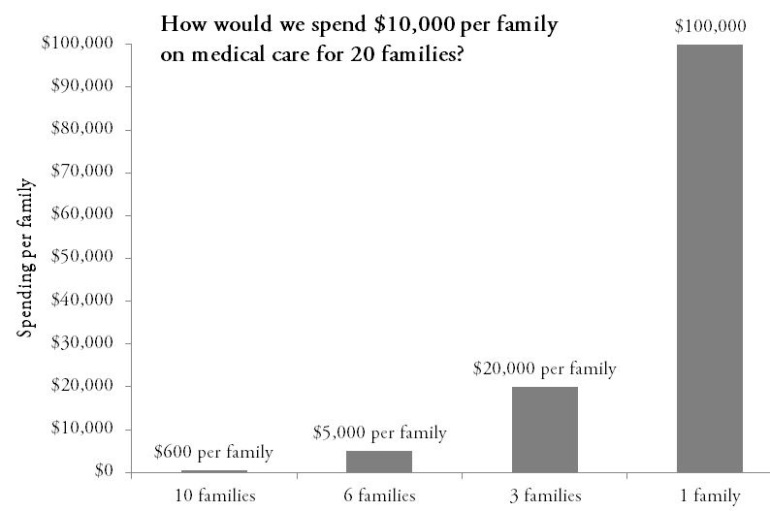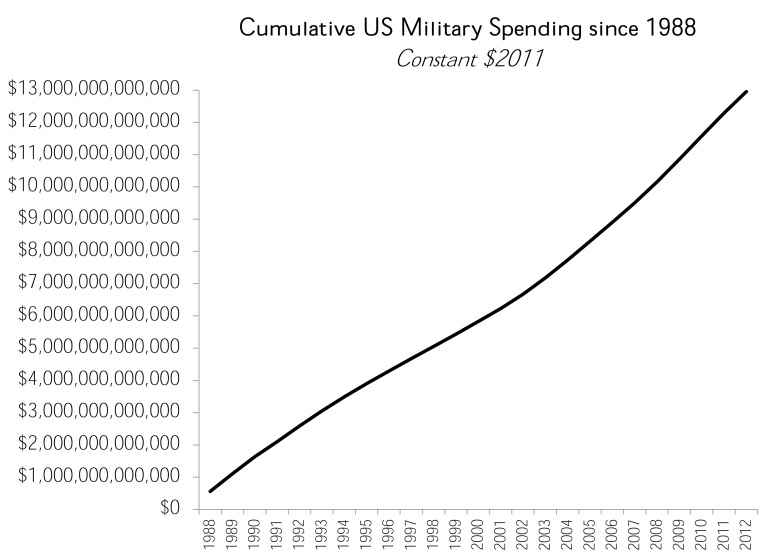With all the money we have given them, why are the poor still poor?
One of the meanest right-wing statistical memes about poverty has been popping up a lot this fall. I saw it most recently in this commentary by Christine Kim, who wrote:
Since the mid-1960s, government has spent more than $19.8 trillion (in 2011 dollars) in total on means-tested welfare programs. With 80 such federal programs, targeted government spending for low-income families – including on health, education, housing, and income supports – totaled nearly $930 billion in fiscal 2011 alone. If converted to cash, this sum would be four times what is needed to lift every poor family out of poverty. About half of this annual means-tested spending goes to families with children. If divided among the 14 million poorest families with children, each family would receive about $33,000. Why, then, have poverty rates remained so high for so long? Clearly, the solution to alleviating poverty is not more of the same.
Brookings’ Ron Haskins used the same numbers, rearranged slightly, to write this in November:
We already spend more than enough money on means-tested programs for poor and low-income people to bring them all out of poverty. There were about 46.5 million people in poverty in 2012, a year in which spending on means-tested programs was around $1 trillion. If that money were divided up among the poor, we could spend about $22,000 per person. For a single mother and two children, that would be over $65,000. The poverty level in 2013 for a mother and two children is less than $20,000. So this strategy would work, but giving so much money to young, able-bodied adults would not be tolerated by the public.
This way of manipulating welfare state spending seems to have originated from Robert Rector at Heritage, who offered it in Congressional testimony in 2012.
This meme is — and I am choosing my words carefully — stupid and evil.
It’s stupid because it ignores how poverty is calculated and how “means-tested” money is spent. If you took away Medicaid and housing support alone, the poverty line for a single mother with two children would have to be a lot higher. For example, according to Rector’s original figures (shared here), half of that means-tested money is spent on medical care, mostly Medicaid. So, Haskins, if you took away Medicaid (and Obamacare subsidies), how much would a single mother with two children need to survive? Health insurance alone would cost her more than $10,000.
So is $33,000 per family such a ridiculously generous amount to live on that it would easily lift people out of poverty? Not without the benefits poor people get. Or if they get sick. In round numbers 10 years old, 5% of the population spends half the money on medical care. Using the distribution reported in that paper, $10,000 per family on medical care is not much, if it’s distributed more or less like this:
Further, all those non-poor families living on $33,000 in employment income are getting benefits, too, like tax-subsidized employer-provided healthcare, mortgage interest deductions, unemployment insurance, and retirement savings. If you took all that away and gave these non-poor families $33,000 to live on, they wouldn’t be non-poor for long. So the argument is stupid.
It’s also evil, because it says, “We’ve thrown so much money at poor people and it just doesn’t work, so it’s time for them to step up and contribute a little themselves.” The main thing Kim wants them to do is get married. She even says, “If single mothers simply were to wed the father of their child, their likelihood of living in poverty would fall by two-thirds,” and adds that, “contrary to myth the fathers are quite ‘marriageable.'”
The calculations for this are not shown, which is probably just as well. But the idea that the “benefits” of marriage — that is, the observed association between marriage and non-poverty — would accrue to single mothers if they “simply” married their partners is bonkers. There is a marriage queue (imperfect of course) that arranges people from most to least likely to marry, and on average the richer, healthier, better-at-relationships people are at the front, more likely to marry and produce the observed “benefits” of marriage. “Marriageable” isn’t a dichotomous condition, but it’s obvious that at any one time the currently non-married are not the same as the currently married.
But back to evil. The idea that we’ve spent so much on poverty that it proves spending doesn’t solve poverty is like saying, “we’ve spent $13 trillion on the military in just the last quarter century, and we don’t have complete world domination yet, so obviously war is not the answer.”
Oh, wait, I do agree with that.
But we don’t spend money on the military and fight wars to fix the world. We do it to fatten defense contractors, provide jobs, prop up unpopular allies, and defend the country from the occasional threat. The defense industry doesn’t have to defend the claim that the spending is a one-time thing to cure a problem.
Giving poor people money — or in-kind benefits — to help them survive is not a solution to poverty, it’s a treatment for poverty. If we had more decency we’d do more of it.



It’s funny how they note that means-tested benefits don’t seem to be effective but conclude that we should make those benefits ever more tightly means tested. Universal benefits alleviate poverty and produce a “we’re all in this together” ethic instead of causing the rich and the people who are just getting by to resent the hell out of people who are not.
LikeLike
I’m with Jodi. But if you don’t like giving money or food stamps to the poor, you could also try other solutions, like raising the minimum wage, or letting the government borrow money to create jobs for people, or letting people pay off student debt and medical debt at reasonable percentages of their salaries. If you’re not interested in any way of helping poor people eat, you’re not trying.
LikeLike
In a small way, I see what you are saying. I think although the poor will always need food and clothing, if we started to give them jobs, then some of them can leave poverty. We need to try to take it case by case and a ripple effect will end poverty. Just giving donations and forgetting about them is not the solution.
LikeLike
This post is unfair to the critics of poverty spending, by characterizing them as Right wing, and the ultimately calling them stupid. Brookings is not a stupid institution. People are not questioning the need of poverty payments, but questioning the efficacy. If the payments had been used for skills training or education, the payoff on dollars would have been more than 1:1. Straightforward cash transfer (140 billion in 2011) is essentially has no payoff. The criticism (whether is true or untrue) is that cash, food and hosing) take up a significant amount on non-medicare expenses, in contrast to job training; and maintains a significant and increasing segment of population in a close-to-poverty setting. The payments, and the percentage of population paid, continuously increases without a review of what is the payoff from these payments.
The comparison with the military spending is odious; let us argue all 1.1 trillion dollars spent on military is magically transferred to the medicaid and cash transfer buckets. Do you think in 2014, there will be even more people in or close to poverty? Questioning government programs is not “stupid and evil”. The point is that some programs can be eliminated, and replaced by, say, childcare programs. Some medicaid payments can be replaced by a medicare insurance premium copay, and so on. There is nothing holy in recommending the existing programs go for eternity, and nothing evil in suggesting some programs be replaced.
LikeLike
Brookings has always been a centrist or establishment think tank. It was ambivalent towards the New Deal and moved to the right in 80s and 90s. Hastings in particular was the conservative force behind the republican welfare reforms that Clinton and the DLC eventually embraced in the 90s.
LikeLike
Words like right wing and left wing have no meaning in United States Politics, where the outcomes of right wingers have been the exact opposite of the words spoken.
During the Ronald Reagan Era (the rightest of right wing), the budget for the Department of Education, more than doubled to $22.7 billion, Social Security spending has risen from $179 billion in 1981 to $269 billion in 1986. The price of farm programs went from $21.4 billion in 1981 to $51.4 billion in 1987, a 140% increase. Medicare spending in 1981 was $43.5 billion; in 1987 it hit $80 billion. Federal entitlements cost $197.1 billion in 1981—and $477 billion in 1987. Foreign aid rose from $10 billion to $22 billion. The net result was unprecedented government debt. Reagan has tripled the Gross Federal Debt, from $900 billion to $2.7 trillion. Ford, Carter and Nixon together had doubled it from 440 to 900 billion dollars in 12 years during the time of recession and war.All said and done Reagan moved Federal spending to the highest ever level.
The Clinton administration did have the largest reduction in federal spending in the past 60 years as measured in percentage of GDP, but the reduction came primarily from domestic cuts – not defense.
In his eight years as President, Clinton reduced federal spending to 18.2 percent of GDP from 22.1 percent, thanks in large part to a Republican-controlled Congress that forced the issue. Defense spending as a portion of GDP declined by 1.8 points, but non-defense spending dropped by 2.2 points. Clinton and the Republicans in Congress cut spending on domestic discretionary programs as well as entitlement spending through welfare reform.
What followed afterward is instructive to the real problem of our current trillion-dollar trajectory of deficit spending. George Bush increased federal spending as a share of GDP by 2.6 points in two terms, and it was not just spent on defense; the increase was split evenly between defense and non-defense spending..
The left is not a big spender on social policies; the right is not a big spender on military. But social spending does have impact as shown in “Trends in Poverty with an Anchored Supplemental Poverty Measure” does show that government welfare programs have significantly reduce the percentage of poor Americans from 26 percent in 1967, to 16 percent in 2012. It just cannot be reduced to “Right” and “Left” Tropes.
LikeLike
and of course Chris Wimer’s “Trends in Poverty with an Anchored Supplemental Poverty Measure”
should be read together with
http://www.motherjones.com/kevin-drum/2013/12/new-study-says-poverty-rate-hasnt-budged-40-years
LikeLike